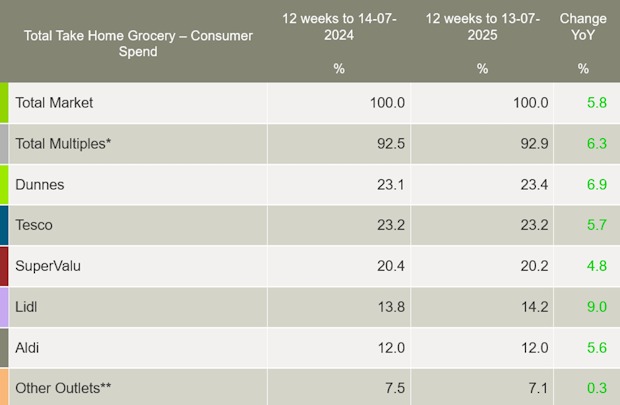Despite erratic summer weather in Ireland, shoppers in the country spent an additional €57.7m on groceries over the four weeks to 13 July, with take-home value sales up 5.2%.
The data from Worldpanel by Numerator shows shoppers visited stores around 22 times in July, but picked up less packs per trip, down 0.6% versus last year. And while grocery price inflation continued to rise, up from 5.3% to 5.43%, shoppers still made the most of the season, spending an extra €46.2m on suncare, smoothies, ice cream, pickles, soft drinks, antipasti and fresh fruit.
“With schools now officially out for summer and many people enjoying the holidays, convenience is key when it comes to meal choices,” said Emer Healy, Business Development Director at Worldpanel by Numerator.
“Shoppers spent almost €1m extra on both fresh and frozen ready meals compared to last year. This is despite a rise in average prices, which impacts shopper behaviour. What we are seeing is much more caution from Irish consumers who actively seek out promotions to get the best deal.”
Shoppers spent €756m on promotional lines during the 12-week period to 13 July, a 9.4% increase compared to the previous year. Key growth categories included pre-mixed alcoholic drinks, soft drinks, frozen confectionery and frozen fruit, all growing ahead of the total market for promotional lines.
Meanwhile, brands continued to grow behind the total market (+5.8%), with growth slowing to 3.7%. Despite this, shoppers still spent an additional €59m on branded products. Own-label saw stronger growth at 6.7%, with premium lines the standout performer, up 16.2%. Shoppers spent nearly €20m extra on these ranges.
Brands currently hold 46.5% value share of the total market in Ireland, with own label at 47.9% value share.
Healy commented: “Our latest Brand Footprint report shows that Irish shoppers still favour nostalgic brands. Over the course of 2024, 39 brands experienced growth in Consumer Reach Points – a metric that considers the number of buyers and how often they buy a product – compared to just 27 in 2023, indicating a more favourable environment for brand growth. We have seen lots of brands with Irish heritage featuring high in the rankings, including Brennan’s, Avonmore & Tayto.”
Online now controls 5.7% of the grocery market in Ireland, with sales rising by 8.1% year-on-year after shoppers spent an additional €15m through this channel. Shoppers purchased their groceries more often online, up 8.5%, contributing €15.7m to its overall performance.
Over the 12 weeks, Dunnes’ market share rose to 23.4%, with sales growth of 6.9%. Shoppers returned to its store more often, up 3.5%, which contributed €27.1m to the chain’s overall performance.
Tesco now controls 23.2% of the Irish market, with value growth of 5.7%. Shoppers increased their trips to its stores by 3.7%, which contributed €28.5m to overall performance.
SuperValu held 20.2% of the market with growth of 4.8%. Consumers made the most shopping trips to this grocer, averaging 25 trips over the 12 weeks. This increase in the number of shopping trips contributed an additional €62.8m to its performance.
Lidl reached a new record market share of 14.2% with value growth of 9%. The discounter also saw shoppers pick up more volume in store, up 4.6%, contributing an additional €20.8m to its overall performance. Aldi’s market share remained at 12.0%, after seeing growth of 5.6%. Increased store trips and new shoppers drove an additional €24.6m in sales.

NAM Implications:
- Brand/own-label balance showing similar trends in terms of brand to own-label switching as other major markets.
- Resulting from cash-conscious shoppers seeking cheaper own-label equivalents
- (with the obvious consequence for brand owners of increased costs of winning back former loyals)
- Meanwhile, the willingness of consumers to shop around for value has benefited the discounters.
- i.e. the combined share of Lidl & Aldi of 26.2% has to remain an issue for the mults.




